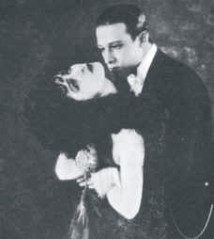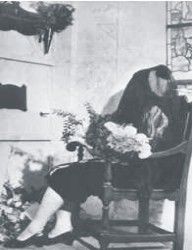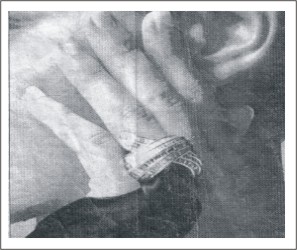
History has enough evidence on the effect of negative gem stones which have devastated individuals and nations alike i.e. Kohinoor, Hope etc. Gem Stones are either good or bad. In fact these negative gem stones are slow killers bringing misery and debilating diseases to the wearer, which they are ignorant of.. You can read one of the documented true incident about a negative influence of a Gem Stone Ring.
Haunts of the Sheik
Spirited Remnants of Valentino
On August 23, 1926, some of the most heartbreaking news of the Silent Screen era reached the general public. New York’s Polyclinic Hospital announced that the screen’s "Great Lover", Rudolph Valentino was dead. His official cause of death was stated to be peritonitis, following an operation for an inflamed appendix. However, in true romantic fashion, other rumors of the star’s demise began to circulate as well. Tales attributed his death to an "arsenic revenge" carried out by a well-known New York society women, who Valentino had dropped after a short affair while he was in town promoting his latest film, "Son of the Sheik". Other rumors said that he had been shot by an irate husband, or that he had contracted syphilis and had died when the disease struck his brain.
During the last years of his life, Valentino had been the dream lover of millions of women and one of the most popular stars of the silver screen. His death was met by chaos as thousands of weeping women filled the streets, mobbed the funeral parlor where his body lay in state and generally wreaked havoc on the city of New York.
What desperate need did this popular actor fill in their lives... and what chasm was torn open by his death? Was the furor over his passing enough to cause his spirit to linger behind?

Valentino was born in Castellaneta, Italy in May 1895 as Rodolpho Alfonzo Rafaelo Pierre Filibert Guglielmi di Valentina d'Antonguolla. He was the bi-lingual and brilliant son of a military officer turned veterinarian and the daughter of a French surgeon. His life was middle-class and comfortable until the premature death of his father. After that, his childhood was marked by a few minor episodes of mischief but he still managed to graduate from a nearby agricultural college. In 1913, he set sail for America on board the S.S. Cleveland. He had little money but was sure that he could succeed in the United States. After a brief stint as a gardener’s assistant on Long Island, Valentino discovered the lure of show business. He first worked as a popular dancer at Maxim's in New York City, then later landed a job touring with "The Masked Model", a show that brought him to California. In the first of a string of bit parts, Valentino's first film appearance was as a dress extra in a ballroom scene in the film Alimony (1917). In just seven years before his untimely death at age 31, Valentino appeared in 14 major films and emerged as a star in every one of them, whether he had the lead role or not. Many of his early roles were minor parts, where he was mainly cast as the villain, thanks to the industry’s narrow opinion of Latin looks. Although he was win the lead role in the 1918 film "A Society Sensation", it would be his part as the "heavy" in 1919’s "Eyes of Youth" that would be a turning point in his career. It would be from this role that June Mathis, a popular screenwriter, would urge that he be cast as "Julio" in Rex Ingram’s epic "The Four Horsemen of the Apocalypse" in 1921. First appearing in a barroom scene, Valentino hypnotized the audience and dance the tango to instant celebrity. As a professional dancer in New York, he had learned to move with grace and finesse in ways that were unknown to many silent films actors of the time. In those days, the actors were almost caricatures of themselves, moving and gesturing with great exaggeration. Valentino managed to make his movements more subtle and in so doing, won many admirers. One such admirer was Dorothy Gish, the popular screen star, who persuaded D.W. Grifffith to cast Valentino in the 1919 film, "Out of Luck". After the "Four Horsemen", Valentino was no longer a "heavy" or a gigolo but a new kind of leading man, one with an exotic appearance and unconventional mannerisms for the time. He brought a sex appeal and a sensitivity to the screen and one that attracted millions of women to theaters. Thanks to the new-found sexual freedoms of "flapperism" and the Roaring ‘20’s, women were coming to the movies like never before... and literally swooning over the new Latin heartthrob. It would be the 1921 film "The Sheik" that would firmly establish Valentino’s reputation as the "Great Lover" and his final film, "Son of the Sheik", that would insure that volumes of fan mail would pour in and continue to come even after his death. Despite the reputation that followed such romantic roles though, Valentino never thought of himself as a conqueror of women. In fact, he thought such films rather silly. Still, the publication of Valentino’s book of poetry "Day Dreams" in 1923 further-fueled the public’s imagination, and drove fans into bookstores with a vengeance. Despite his adoration by the female public, Valentino got more than his share of abuse by the newspapers and magazine columnists of the time. Many hinted that the “sensitive” actor was a homosexual and often questioned his virility. One article, penned by an editorial writer for the Chicago “Tribune” had Valentino so angry that he challenged the man to a fight. This was not the only attack that he suffered though and such writings found their origins with Valentino himself. His eccentric tastes and extravagances made him the target of many such writers, along with his famous “slave bracelet”, without which he was never seen in public, his gold jewelry, his preference for heavy perfumes, mink coats and other oddities. His virility was further questioned when it became known that both women he married were lesbians. When Natacha Rambova, Valentino’s second wife, divorced him in 1926, it was revealed that their marriage had never been consummated. A similar charge had been made in 1922 during the divorce proceedings from his first wife, Jean Acker. To make matters worse, Valentino had married his second wife before his divorce from Jean Acker has been finalized. This small oversight led to a charge of bigamy. Apparently, the “Great Lover” was not so adept at romance after all. Whatever his private accommodations with his wives may have been, the slurs against Valentino’s virility plagued him until his dying day. As he lay on his deathbed, stoically fighting against incredible pain, he was said to have asked one of his doctors, “And now, do I act like a pink powder puff?”, he questioned, in reference to the Chicago “Tribune” editorial. At the news of Valentino’s death, two women attempted suicide in front of the hospital. In London, a girl took poison before his inscribed photograph. An elevator boy at the Ritz in Paris was discovered dead on his bed, which was covered in photos of Valentino. While the actor was lying in state at Campbell’s Funeral Home in New York, the streets outside became the scene of a macabre carnival as a mob of over 100,000 women (and some men) fought for a last glimpse of Valentino. Among those who were permitted into the candle-lit viewing room of the funeral home were his ex-wife, Jean Acker, whose display of rabid grief beside her former husband’s casket may have been less extreme is she had known then that Valentino had only left her a solitary dollar in his will, and film star Pola Negri, who upstaged everyone with her designer mourning clothes. She sobbed and fainted before the coffin and, of course, before the photographers. Between her bursts of weeping, she claimed that she and Valentino had planned to be married. Another claim of eminent nuptials was produced in the newspapers a short time later by Ziegfeld girl Marion Kay Brenda, who stated that Valentino had proposed to her in Texas Guinan’s nightclub the evening before he was felled by his illness. To add to the carnival-like atmosphere, a commemorative song began to be played on radios across America at the same time that Valentino’s body was being shipped west to the Hollywood Memorial Park Cemetery. The song, crooned by Rudy Vallee, was called “There’s a New Star in Heaven Tonight - Rudy Valentino”. Another legend grew up around the crypt of Valentino in the Hollywood cemetery. It seems that since the demise of the star in 1926, a “Lady in Black” has put in an appearance at his tomb and each week, leaves a fresh bouquet of flowers. There is no way to know if this might be the same woman after all of these years, but regardless, the flowers have never stopped coming. I visited Hollywood Memorial Park a few years ago and visited the crypt. Not surprisingly, fresh flowers were still appearing each week.

Most Likely a staged photo that is supposed to depict the legendary "Lady in Black"
And this isn’t the only legend. Apparently, a few years back, stories began to circulate about a cursed ring that some believe may have led to Valentino’s early death. According to the story, he bought the ring in 1920 in a San Francisco jewelry store, even though the owner told him that it had brought bad luck to everyone who had owned it previously. Valentino shrugged off the tale and bought the ring anyway. He wore the ring in his next film, “The Young Rajah”, which turned out to be the biggest flop of his career. Valentino was just getting started at that point and this film was so bad that it kept him off the screen for the next two years. Wondering if the story of bad luck might have been true, he put the ring away and did not wear it again until his trip to New York after making “Son of the Sheik”. While wearing the ring, he suffered an acute attack of appendicitis and within two weeks was dead. A short time later, Pola Negri was asked to choose a memento from among Valentino’s things and not knowing the strange tales behind it, chose the silver ring. Almost immediately, her health failed and an unknown ailment almost ended her career.
A year later, while still recuperating from the odd sickness, she met a manthering named Russ Colombo, who was almost a “double” for Rudy Valentino. When Pola Negri was introduced to him, she was so struck by the resemblance between Colombo, a struggling singer, and the later actor, that she presented him with Valentino’s ring. “From one Valentino to another,” she said. Within a few days of receiving the ring, Colombo was killed in a mysterious shooting accident.

His cousin then gave the ring to Russ’s best friend, Joe Casino, an entertainer. Taking no chances with the ring, Casino placed it in a glass case and refused to remove it, even when a request came to donate it to a museum of Valentino relic. Eventually though, Casino began to disregard the stories behind the ring and he decided to wear it. A week later, still wearing the ring, he was run over by a truck and killed. Joe’s brother, Del, then came into possession of the ring but he laughed at the idea of a curse and vowed that he would not be intimidated by “old wife’s tales”. For quite some time, he wore the ring and suffered no ill effects from it. He also loaned it to a Valentino collector, who also had no problems. Many speculated that the story of a “curse” may have been nothing more than a series of bad coincidences. Then, one night, the home of Del Casino was robbed. The burglar, a man named James Willis, was seen by the police running from the scene. A policeman fired at him ( a warning shot, he later claimed) and Willis was killed. Among the stolen loot was the dreaded Valentino ring.... Around this same time, a producer named Edward Small decided to make a film about Valentino. Jack Dunn, a skater, was asked to film a test for the part and he dressed in one of Valentino’s old costumes for the part. He also wore the ring! Although only 21 years old at the time of the screen test, Dunn died ten days later from a rare blood disease. The ring was then placed out of sight and never worn by anyone. A year after Dunn’s death, a daring bank robbery took place at a Los Angeles bank and the thieves got away with more than $200,000 in cash. In the police ambush that followed, two of the gang were caught and three onlookers were injured. The leader of the bank robber’s, Alfred Hahn, was later convicted and sent to prison for life. At his trial, Hahn stated, “If I had known what was in that bank vault, apart from the money, I’d have picked myself another bank.” What Hahn hadn’t know was that in the safe deposit vault of the bank was the Valentino ring! The executors of Del Casino, who took over ownership of the ring after his death, continued to store it under lock and key. For many years, it remained inside of the bank vault, where over a five year period a $50,000 bank robbery, a fire and a three-week cashier strike occurred. Can an inanimate object exert such a malign influence those who come in contact with it? Those who fell under the curse of the Valentino ring certainly believed that it could! And perhaps it still does.... the last report of the whereabouts of the ring come from the late 1960’s. Who knows where it might have been during the last 30 years or so.... and who knows what kind of havoc it may have wreaked??
Haunted Places: The National Directory by Dennis William Hauck (1996)
Hollywood Babylon by Kenneth Anger (1975)
Hollywood Babylon II by Kenneth Anger (1984)
Hollywood & The Supernatural by Brad & Sherry Steiger
The Strange & The Uncanny by John Macklin (1967)
Hollywood’s Unsolved Mysteries by John Austen (1970)
Ghost Stalkers Guide to Haunted California by Richard Senate (1998)
Lamparski’s Hidden Hollywood by Richard Lamparski (1981)